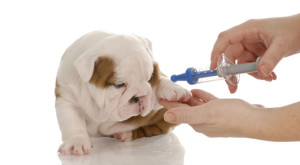Posts Tagged ‘lyme disease’
How To Protect Your Pet From The Heat
 Protecting your pet from the heat is extremely important. As temperatures rise, it becomes more and more uncomfortable to be outside. This is true for your dog as well. During the summer, it is healthier for your dog if you limit outside time, time in dog parks, and exercise to cooler parts of the day, such as morning and evening times. It is not always the temperature as well. The humidity can cause your dog to have difficulty panting. Panting helps your dog cool itself off. Without being able to pant, your dog’s temperature can rise that can lead to heatstroke. If your dog is exhibiting any of the signs of overheating (heavy panting, heavy drooling, trouble breathing, rapid heartbeat, dark or red gums and tongue, dizziness, and weakness, or agitation), be sure to bring your dog to the vet right away. To avoid overheating, there are multiple things that you can do to keep your puppy cool during the hot summer.
Protecting your pet from the heat is extremely important. As temperatures rise, it becomes more and more uncomfortable to be outside. This is true for your dog as well. During the summer, it is healthier for your dog if you limit outside time, time in dog parks, and exercise to cooler parts of the day, such as morning and evening times. It is not always the temperature as well. The humidity can cause your dog to have difficulty panting. Panting helps your dog cool itself off. Without being able to pant, your dog’s temperature can rise that can lead to heatstroke. If your dog is exhibiting any of the signs of overheating (heavy panting, heavy drooling, trouble breathing, rapid heartbeat, dark or red gums and tongue, dizziness, and weakness, or agitation), be sure to bring your dog to the vet right away. To avoid overheating, there are multiple things that you can do to keep your puppy cool during the hot summer.
To begin, make sure to keep your dog groomed, especially if they have long fur. Each breed has different needs. For example, dogs with short, thin coats handle heat better than cold weather and mountain dogs. No dog is immune to heatstroke or paw pad burns, so it’s important to keep your dog groomed. If you get any mats and tangles out of their fur, it will help keep them cool. However, don’t shave or clip their coat until you talk to your vet or groomer. The extra fur that helps your dog stay warm in the winter may also keep it cool in the summer. To keep your dog’s paw pads safe, stick to shaded areas or bring insulation booties to protect your dog’s feet from the hot pavement. To test the heat of the pavement, feel it with the back of your hand. If it is too hot for you, then it is definitely too hot for your dog.
Similarly, be sure to keep your dog’s shots up to date, especially in the summer. The parvovirus spreads in hot weather. During the summer, your dog probably spends more time outside which means that it could come in contact with an animal that has rabies. Summer is also a high season for fleas and mosquitos, both which carry many diseases. By giving your dog medication to prevent these pests, your dog will be safer in the long run.
This should go without saying but leave your pet at home unless your destination is pet friendly. Do not leave your pet in your car. Even with the windows of your car cracked, the temperature inside the car rises rapidly in the summer heat. Similarly, keep your dog’s water supply full. Be sure that there are multiple bowls available for your dog that are always filled with fresh water that is clean. Even if you think that the walk you are going on will be short, be sure to bring clean drinking water and a dish that your dog can easily drink from. If you are worried that your pet is not drinking enough water, add some ice cubes to the bowl. It will make drinking water more appealing to dogs.
When you are spending days outside by a pool or a lake, you can do many things to keep your dog cool while you enjoy the summer sun. You can freeze containers of water so that they will stay cooler for longer. Be sure to keep their water in the shade. You can also provide a small kiddie pool or a sprinkler for your dog to play in. These allow fun places for your dog to cool off and maybe even get some exercise. Similarly, you could put a pet-friendly dig area for your dog in your yard. These can include a sandbox area that your dogs are able to dig in. Dogs often dig a hole to sit in and keep cool. To make an even cooler area, you can spray sand with your cold water. Be sure to make sure that it is located in the shade and not in the sun.
Sometimes, a little extra help is needed to cool your dog. Dog cooling mats and cooling vests are great products. Many work by soaking them in cool water for a long time. If you don’t have access to these, you can soak a towel in cool water and let your dog lie on it. You can also spray your dog’s belly and paws to cool them down. Dogs will cool down more quickly through their belly and paws than water sprayed on their back. Another great DIY to keep your dog cool is to put a pan of ice water in front of the fan to make it more effective for your pup to stay cool.
There are many similar DIYs to keep your pet cool in the summer. Dog-Safe ice cream exists, and you can make it at home. Here is a big list of easy to make ice creams that won’t cost an arm and a leg unlike the gourmet pet store ice-creams. You can also make some frozen treats to put in your dog’s favorite toy. Kong toys come in all shapes and sizes because all dogs love them. They are tough rubber chew toys that are meant to be filled with yummy sticky treats like peanut butter to keep your dog occupied for a while. There are pet-friendly recipes available that are meant to be frozen to keep your dog refreshed while they lick the center. Similar to the Kong treats, you can freeze your dog’s favorite treats in a popsicle mold and fill it with water. It will give your dog a fun treat to keep them cold.
The summer gives many fun opportunities for you and your family. You wouldn’t allow a member of your family to overheat, so don’t let your dog (a furry family member). By following the simple rules of pet care and making some fun treats that your dog will enjoy, you and your dog can have a healthy and cool summer! Make sure to contact our office if you have any questions!
Parasite Prevention And Your Pet
 Parasite prevention and your pet is something very important. With summer fast approaching, pet owners are more active with their pets outside. That is where you will find parasites that can infest your pets, several of which can infect people as well. So because of this, parasite prevention is not only important for the health of your pet but also for the health of your family.
Parasite prevention and your pet is something very important. With summer fast approaching, pet owners are more active with their pets outside. That is where you will find parasites that can infest your pets, several of which can infect people as well. So because of this, parasite prevention is not only important for the health of your pet but also for the health of your family.
As a veterinarian, we generally talk about controlling and preventing four major parasite groups—Fleas and Ticks, Intestinal Parasites, and Heartworms.
Fleas and Ticks
Fleas and ticks are troublesome parasites of the skin. Not only are they troublesome because they cause problems with the skin, they also transmit several diseases to your pet. There are many effective products out there that can be purchased from your veterinarian to control and prevent flea and tick infestations. Regular use of these products can prevent fleas and ticks from becoming a problem to your pet. As tempting as it might be to purchase an over the counter product from your pet store or big box store, I would caution you as a pet owner to be very careful. Many of these products can have serious side effects if used improperly and may have limited effectiveness.
Intestinal Parasites
Intestinal parasites can cause pets to vomit, have diarrhea, lose weight, and lead to a poor overall condition of your pet. The most common intestinal parasites in cats and dogs are roundworms, hookworms, whipworms, tapeworms and coccidia. All of these parasites can have the ability to affect your pet. Additionally, some roundworms, hookworms, and some tapeworms can also affect humans. Because of this, pet owners should contact their veterinarian to check on a routine testing schedule and monthly preventatives.
Most parasites cannot be seen with the naked eye in the feces. Your veterinarian can diagnose the infestation by taking a sample of the feces and looking at it under a microscope. The Companion Animal Parasite Council recommends that a fecal analysis be performed 2 to 4 times during a pets first year of life and at least 1 to 2 times per year for adults.
Because your pet can get exposed to intestinal parasites at birth and an early age of life, the CAPC recommends that puppies and kittens should be dewormed every 2 to 3 weeks until they are 12 weeks old and animals that are older should be dewormed at least twice. Once the initial deworming is complete, dogs and cats should be put on a monthly, year-round product that prevents intestinal parasites as well as heartworm infections.
The area where your pet eliminates can become contaminated with intestinal parasite eggs. This can cause reinfection to your pet or exposure and infection of future pets or humans. Immediate removal of the feces from the yard greatly reduces the chance that the property will become contaminated with the intestinal parasite.
Heartworms
Heartworms are a parasite that resides in the heart and is transmitted through the bite of a mosquito. This mosquito is harboring the larva of the heartworm and it is injected with the saliva into the bloodstream of the dog. The larva migrate to the heart where they mature and become adults. Over time, heartworms can cause exercise intolerance, heart failure and respiratory problems in dog. Fortunately, heartworms are preventable. There are several fantastic monthly preventative options available through your veterinarian. When given year-round, these products will provide protection against heartworms and several other intestinal parasites and fleas that can infect dogs, cats and people. Your vet would be a good source to help you decide which product is best for you and your pet.
Here at the Olsen Veterinary Clinic we carry products to protect your pets. Stop in or give us a call and we would help you decide what is best. You are always welcome to contact us here with questions.
What To Look For If Your Pet Is Bitten By A Tick
 With the spring weather rapidly approaching, you and your pet are probably excited to get out and explore the great outdoors. However, lurking in the woods are some old eight-legged nemesis’ that can cause harm to your pets. If your pet is bitten by a tick, it can spread harmful diseases through their bites.
With the spring weather rapidly approaching, you and your pet are probably excited to get out and explore the great outdoors. However, lurking in the woods are some old eight-legged nemesis’ that can cause harm to your pets. If your pet is bitten by a tick, it can spread harmful diseases through their bites.
Each year thousands of dogs are infected with dangerous tick-transmitted diseases-with the risk rising. Between 2006 and 2010 there was a 30 percent increase in the rate of dogs exposed to tick-transmitted diseases.
Ticks are parasites that attach themselves to dogs and cats, feed on their blood and transmit diseases directly into the their system. There are many tick-borne diseases seen throughout the United States. Some of the major tick-borne diseases that are seen in the Midwest include:
- Lyme disease, which is spread by the deer tick, can cause enlarged, swollen and sore joints with a loss of appetite, fever and fatigue. Severe cases can lead to kidney disease and heart disease. There are vaccines that are available for dogs to prevent the dog from getting infected with it.
- Canine ehrlichiosis, Carried by the brown dog tick, this disease is the most common and one of the most dangerous tick-borne disease organisms known to infect dogs. This disease can cause depression, anorexia, fever with stiff, painful joints and bruising. Severe cases may include dogs suffering with seizures. There are no vaccines available. If it is diagnosed, antibiotics are used to help control the bacterial numbers in the dog.
- Anaplasmosis, also called dog fever or tick fever, is transmitted from the deer tick. It is seen in both dogs and cats. Like most of the other related diseases, clinical signs include pain in the joints and fever. Anaplasmosis can also cause diarrhea and nervous system disorders. The clinical signs usually persist about 2 weeks after the tick bite. It is also treated with long term antibiotics.
- Rocky Mountain Spotted Fever comes from the American dog tick, the wood tick and the lone star tick. Symptoms include fever, stiffness, neurological problems and skin lesions. Typically the illness last about two weeks, but serious cases can result in death.
- Babesia is a protozoan organism that is transmitted to dogs and cats from the American dog tick or the brown dog tick. This protozoan then attaches to the red blood cells and causes anemia. Severe signs in dogs include pale gums, depression, dark-colored urine, fever and swollen lymph nodes. Collapse and shock can be seen in severe cases. There are no vaccines available.
- Tularemia is seen more in cats than dogs. With this disease in cats, a high fever, swollen lymph nodes, nasal discharge or abscesses may be seen. Dogs tend to present with a reduced appetite, depression, and a mild fever.
- Hemobartonella is a tick-borne disease that causes the red blood cells to break down leading to anemia and weakness. In cats it is known as Feline Infectious Anemia. Treatment consists of long term antibiotics with blood transfusions possibly necessary in severe cases.
- Tick paralysis is caused by a secreted toxin from ticks. It affects the dogs’ nervous system with weakness starting in the rear legs and progressing to all four legs followed by breathing and swallowing difficulties.
The key to curing tick-borne disease is early diagnosis and treatment. Several broad-spectrum antibiotics are generally effective, especially in the early stages of the disease. Since antibiotics don’t differentiate between the “good” and “bad” bacteria, you may want to add a probiotic to avoid gastrointestinal problems. Be sure to follow the advice of your veterinarian.
There are numerous products and medications available to prevent ticks on your pet over the counter and from your veterinarian. No method offers 100 percent protection. If you have a field dog, they are vulnerable to tick-borne diseases because of the time spent in the tick-infested environment. So owners should diligent about applying topical and systemic treatments before outings. It is important to check your pets daily during the tick season and be removed properly if present. Ticks need to be embedded at least 24 to 48 hours to spread infections, so if checked every day, then the risk of infections being spread are lessened.
Tick-borne disease can rebound rapidly if your pet’s treatment only succeeded in suppressing rather than killing ticks. Since recurring tick diseases are harder to control or eradicate, don’t relax too soon if your pet recovers. Make sure that your pet has recovered completely and give it time to get back to recover completely. To further protect your pet, remain vigilant with regular blood work to detect recurrences.
Finally, to make an informed decision about protecting your pet from tick-borne diseases, talk to your veterinarian about the best tick-control approach for your dog.
Why Should I Vaccinate My Pet?
“I figured, what’s the worse that could happen? If he got sick, I’d take him to the vet. Well, he got sick. Real sick. It kills me to think about how scared, how weak he looked, and how despondent my kids were. He was the star of the house. And he was gone, just like that.”
Some days in our clinic, we see this. Clients bringing in their lifeless pets for us to treat and nurse their beloved pet back to health. Sometimes this could have been preventable if only they had vaccinated their pet.
If you have paid attention to the media, there is a lot of discussion on whether you should vaccinate your children or not. Unfortunately, this discussion also crops up in veterinary medicine—whether to vaccinate your pet or not.
There are only two reasons to vaccinate. They are to protect your pet and protect the pets and people around us. Cat and dog diseases still exist and can infect any pet that is not protected. You never know when or where your pet can be exposed. Vaccinations are the best way to stimulate the immune system to stop diseases when exposed and for the vast majority of pets, the benefits of vaccinating far outweigh the risks.
We can’t depend on other pet owners to provide the proper vaccinations to their pets so that our pet has less opportunity to get a disease. So by vaccinating we are cooperating will all individuals to reduce the possibility of spreading disease.
There are several reasons that you should vaccinate your pets. The first and foremost is that with some diseases, it is the law. It is mandatory that you have your pet vaccinated against rabies in every U.S. State. Even pets kept indoors can potentially be exposed if the get out unexpectedly or an uninvited animal gets in the house. The important thing about rabies is that humans can get it and it is fatal.
Several diseases can be transmitted from pets to humans such as rabies and Leptospirosis. Vaccinating your pet helps reduce the risk of human infection and is especially necessary if there are young, elderly, or immune-compromised members in your household.
Many people have their pet groomed, boarded, or attend doggy daycare. If you do, most places require that you pet have a vaccine against kennel cough. This disease is a hacking cough that is highly contagious. Although the disease is relatively mild, it can sometime lead to severe pneumonia.
Young unvaccinated puppies are at risk to contracting parvovirus. This is a severe life-threatening infection that causes bloody diarrhea and vomiting to the point of shock and even death. Parvovirus is extremely contagious and puppies are most at risk. This disease is almost 100% preventable with vaccination.
Puppies can get a severe neurological, dermatologic, and respiratory disease called distemper. Most dogs that contract distemper and euthanized due to the progressive nature of the disease. This disease can also be prevented by timely vaccinations.
There are other diseases such as hepatitis, Lyme disease, and Leptospirosis that can be prevented by vaccinating your puppies.
Believe it or not vaccinating can save money. Most veterinary vaccinations are relatively inexpensive. Vaccinations are definitely less expensive that the cost of treatment for the diseases that they protect against.
An ounce of prevention really is worth a pound of cure. Many dangerous diseases seen in dogs and cats are completely preventable with the right vaccinations. Vaccinating gives pet owners peace of mind and helps pets lead safe and healthy lives.
If you have questions, or are still unsure about vaccinations for your pet, contact our office today.
Preventing Tick-Borne Disease
 Ticks are a world-wide problem. They carry several diseases that can threaten the health of your dog. Such diseases include Ehrlichia, Anaplasma, Rocky Mountain Spotted Fever, and Lyme Disease. These diseases present us with different symptoms and most are difficult to diagnose in the early stages without aggressive diagnostic testing and prompt treatment. Depending on the disease, we can be presented with clinical signs that include lethargy, neurological deficits, deficiencies of all blood elements, high fever, arthritic pain, kidney failure, paralysis, and ultimately death. Early diagnosis and proper treatment is essential for positive outcomes.
Ticks are a world-wide problem. They carry several diseases that can threaten the health of your dog. Such diseases include Ehrlichia, Anaplasma, Rocky Mountain Spotted Fever, and Lyme Disease. These diseases present us with different symptoms and most are difficult to diagnose in the early stages without aggressive diagnostic testing and prompt treatment. Depending on the disease, we can be presented with clinical signs that include lethargy, neurological deficits, deficiencies of all blood elements, high fever, arthritic pain, kidney failure, paralysis, and ultimately death. Early diagnosis and proper treatment is essential for positive outcomes.
In order to prevent tick infestations, we must first understand the ticks environment and life cycle. Environmental prevention is based on what we know about the tick, which seems to be geared toward only two things, reproduction and survival, both of which depend on blood.
An adult female tick gets impregnated by a much smaller male and then engorges itself on the blood of an animal, it falls off and dies after laying a batch of eggs that may number in the thousands. The tiny, six-legged larvae that emerge from the eggs do not all survive, but the ones that do attach themselves for their first blood meal on small mammals like field mice. This is where the trouble can start for dogs if that mouse is a carrier-host for tick-borne disease since ticks are usually not born infected.
After feeding, the larvae molt, become nymphs and gain another pair of legs and the chance to become a carrier if the larger animal they feed on has a tick borne disease or pass infection on if they are already a vector from feeding on the small mammal.
Most ticks will climb on a grass blade or low-hanging tree branch and wait for your pet to come along, holding up their front legs in anticipation of grabbing hold. The ticks have chemoreceptors in sensory organs that act as taste buds on their front legs that they use to find their next meal. They know us by the carbon dioxide that the dogs and we breathe out, moisture, body heat and butyric acid which is a chemical that all mammals give off. So when a dog brushes by a tick, it will latch onto its fur and start looking for a place to attach and feed.
Not all ticks carry disease, but because of the numbers that exist makes sense to do everything possible to protect our dogs from being bitten. The way the tick behaves gives us clues how to keep the ticks away.
Obviously, since ticks like tall grasses and low-hanging tree limbs, it is best to cut the grass and remove the branches. It is also good to keep dogs away from areas where there could be small rodents such as stone walls and wood piles.
You can also spray the surroundings with a mild dish soap like Ivory with a garden sprayer. This detergent will also kill the honey bees, so do this in the evening when they are not around. Ticks do not like sulfur because of the pungent odor to their sensory organs.
There are several preventatives that are on the market that prevent ticks. Most of the good ones contain Amitraz. But do not use the products that contain Amitraz and permethrin on cats because they are toxic to them. Frontline Plus which is made by Merial contains Fipronil which is safe for cats.
The only tick-borne disease that has a vaccine available for prevention is Lyme disease. It works best in young dogs that have never been exposed before and must be given every year. Dogs have been known to get Lyme even though they have been vaccinated. Most veterinary teaching hospitals do not recommend it unless you live in an area where there is a strong likelihood of infection. The ease with which Lyme can be detected and treated may weigh against using the vaccine. Very rarely, dogs can have a reaction to the vaccine which leaves them with all the painful symptoms of Lyme disease but no hope of being cured as there is no disease to fight. Unfortunately, you cannot know if yours will be one of them before you vaccinate. However, many have been vaccinated and suffered no serious reaction and appear to be protected by the vaccine.
The best and safest way to remove a tick is to use a small curved Kelly forceps or a pair of tweezers or one of the tools especially made for the purpose, catch the tick right behind the flattened head as close as possible to the dog’s skin, and pull gently and straight out. Do not ever try to remove a tick with your fingers, burn it, put petrolatum jelly on it, twist it or jerk it. By grasping the tick with your fingers, you risk propelling the infectious saliva from the tick into your dog. After removing the tick drop it in a solution of water and dish soap to kill it.

